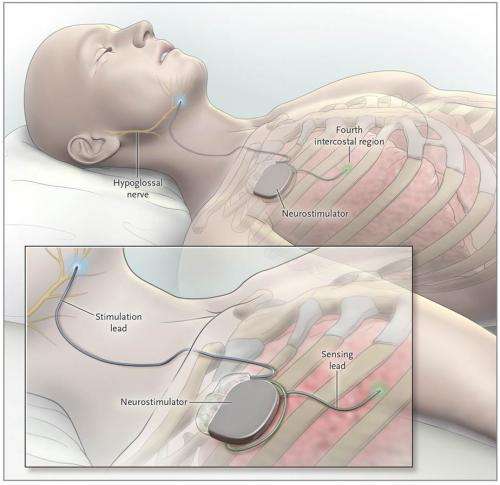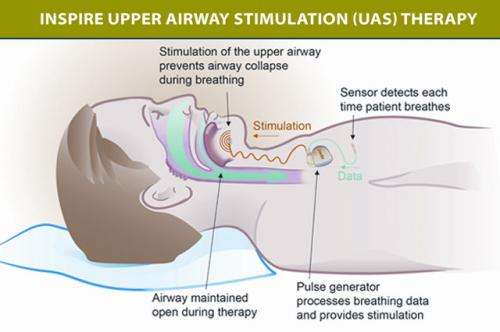New device can reduce sleep apnea episodes by 70 percent, study shows

Implantation of a sleep apnea device called Inspire Upper Airway Stimulation (UAS) therapy can lead to significant improvements for patients with obstructive sleep apnea (OSA), according to a study published today in the New England Journal of Medicine. After one year, patients using the device had an approximately 70 percent reduction in sleep apnea severity, as well as significant reductions in daytime sleepiness.
The multicenter, prospective Stimulation Therapy for Apnea Reduction (STAR) trial was conducted at 22 medical centers in the United States and Europe, and is the first to evaluate the use of upper airway stimulation for sleep apnea.
OSA, which affects more than 8 million men and 4 million women in the U.S. and is twice as common in men, is characterized by repeated episodes of upper airway collapse during sleep, due to narrowing or blockage. Patients with OSA stop breathing, known as apnea, frequently during sleep, often for a minute or longer, and over half of those with OSA are overweight. Repeated episodes of apnea can lead to daytime fatigue, and increase a person's risk for heart attack, stroke, high blood pressure and even death.
Treatments for OSA include weight loss, upper airway surgeries, oral appliances, and continuous positive airway pressure (CPAP), which is considered the primary treatment for OSA.
"While CPAP is a successful treatment when used on a regular basis, as many as half of the patients who have been prescribed CPAP are unable to use it regularly, largely due to discomfort with the mask and/or the lack of desire to be tethered to a machine," said Patrick Strollo, M.D., professor of medicine and clinical and translational science at the University of Pittsburgh School of Medicine, medical director of the UPMC Sleep Medicine Center, and lead author of the study. "The results of this trial show a huge potential for a new and effective treatment that can help millions of patients."
"Inspire UAS therapy differs from other traditional sleep apnea devices and surgical procedures in that it targets the muscle tone of the throat rather than just the anatomy," noted Ryan Soose, M.D., director of the UPMC Division of Sleep Surgery and assistant professor at the University of Pittsburgh School of Medicine, Department of Otolaryngology. "Two thirds of patients using the Inspire UAS therapy device had successful control of their OSA although even more reported improvement in snoring, daytime sleepiness and quality of life measures. Eighty-six percent of patients were still using the device every night at the one year mark, which compares very favorably to CPAP."
From 724 candidates initially screened, the STAR trial implanted and prospectively evaluated 126 moderate-to-severe OSA patients who had difficulty using or adhering to CPAP therapy:
- 83 percent of the participants were men, the mean age was 54.5 years, and the mean body-mass index was 28.4.
- All patients underwent surgery to implant the device. The device stimulates the nerve of the tongue during sleep, thereby enlarging and stabilizing the airway and improving control of breathing.
- Surgical implantation of the upper-airway stimulation system was performed by otolaryngologists at 22 academic and private centers, including Ryan Soose, M.D., of UPMC Ear, Nose and Throat specialists.
- The device was implanted in three areas: a stimulation electrode was placed on the hypoglossal nerve, which provides innervation to the muscles of the tongue; a sensing lead was placed between rib muscles to detect breathing effort; and a neurostimulator was implanted in the upper right chest, just below the clavicle bone.
- Patients used a "controller" to turn on the device at night, so it is only used when the patient sleeps. The Inspire UAS therapy device is designed to sense breathing patterns and deliver mild stimulation to a patient's airway muscles to keep the airway open during sleep.
- Using various sleep-disorder measuring systems, patients were found to experience 68 to 70 percent fewer sleep-apnea episodes per hour.

"My short-term memory has improved significantly, and the surgery has made a huge difference in my quality of life," said Kathy Gaberson, one of the study participants who used the Inspire therapy. "My apnea episodes went from 23 times an hour to just two."















